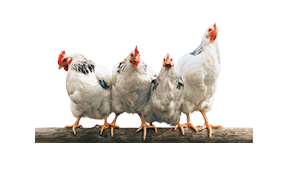Birdology: Adventures With A Pack of Hens, A Peck of Pigeons, Cantankerous Crows, Fierce Falcons, Hip Hop Parrots, Baby Hummingbirds, and One Murderously Big Living Dinosaur
Simon & Schuster, ISBN 978-1416569848
“Naturalist and acclaimed New Hampshire author Montgomery’s rhythmic and lyrical subtitle conveys the feel of this entertaining, eye-opening book about birds and the people who love them. If you’re one of those who think crows are just raucous marauders and pigeons no more than rats with wings, this book may transform your thinking.
“Not much gets past a pigeon. They notice details that humans miss: one study found that pigeons could learn to recognize the difference between the painting style of Manet and that of Monet faster than many college students. At one time, the U.S. Coast Guard trained pigeons in helicopters to spot orange life vests at sea; they outperformed human spotters three to one.” One wonders why they are no longer used but Montgomery doesn’t go into this. She has a lot of territory to cover. Beginning with her own 20-year flock of chickens, Montgomery celebrates birds — their individuality, biology and abilities. She opens each chapter with specifics — the people involved and the birds they are involved with — then ranges into the science surrounding the species, exploring their specialized anatomy and the many behavior studies.
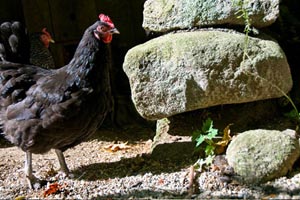
Enraptured by her free-ranging chickens, affectionate hens who exhibit individual personalities, she intertwines an intriguing account of their lives and habits with results of studies on chicken communication and rooster behavior. But things change when a new flock of chickens takes up residence beside her own. “Everything the Rangers do is writ large. My hens are gentle, subtle; they are Ladies. The Rangers are drama queens.” Observation drives her to the stunning conclusion that chicken culture is passed down through generations in one flock “of unrelated chickens of different breeds.”
Covered with persistent leeches, torn by thorns, Montgomery bleeds and sweats through the rainforests of Australia in search of the big, flightless, elusive cassowary. Genetically alien to us, birds are descendants of dinosaurs and the ancient cassowary is the best exemplar.
At the opposite extreme are the tiny, dynamic hummingbirds. Montgomery visits a woman who raises and frees orphaned hummingbirds near San Francisco (which has 400 species!). Designed for flight, birds are almost more air than substance, and hummingbirds take this biology as far as it can go. Almost two weeks old, two baby siblings “weigh less than a bigger bird’s single flight feather.” If they survive they will be able to “hover, fly backward, even fly upside down.” Some hummingbirds can dive at more than 60 miles per hour.
Montgomery feeds us marvels of hummingbirds while the birds are fed every 20 minutes, without fail, all day long (everyone gets to sleep through the night). Though starvation is never far away, fledging is even more terrifying as there is nothing a hummingbird hates more than another hummingbird, and that includes any hapless fledglings not their own.
Then Montgomery learns falconry, a fraught experience for a dedicated vegetarian and animal lover, but the thrill of the hunt opens new vistas. “A raptor’s vision is the sharpest of all living creatures,” she tells us. An eagle at 1,000 feet can spot prey across three square miles. Flight demands such quick comprehension that, because of specialized brain circuitry “birds capture at a glance what it might take a human many seconds to apprehend.” “Raptors see in such fine detail that humans need microscopes to begin to imagine it.”
Birds are also thought to see colors we cannot even describe. At Irene Pepperberg’s lab (famous for Alex, the African grey of Alex and Me) Montgomery sits in on a training session. Asked to name the color of various objects, the young subject bird seems annoyed and frustrated. On a hunch, one of the experimenters paints all his orange toys the same color orange and the frustration disappears. For her birthday Montgomery went dancing with Snowball, made famous from a You-Tube video (if you haven’t seen it, do). Snowball lives in a rescue home with a lot of other parrots because he fell in love with his previous owner’s daughter and was violently offended when she left him and went away to college.
The crows wind things up. Smart toolmakers and users, crows are less beloved for their urban winter roosting habits. In Auburn, N.Y., the winter population is 28,000 people, 50,000 crows. And they prefer downtown. Why is a matter of some speculation — warmth from the asphalt and concrete, perhaps, or the excellent Dumpster dining, or the bright lights that make predators visible. Montgomery visits the place when the city fathers decide to rid themselves of the crows once and for all.
Montgomery’s stories are funny, sad, poignant and fascinating. Her writing is engaging and she shares vast swaths of the latest research. Which brings up my only complaint. I would have liked some chapter notes. There is an index and a useful chapter-by-chapter bibliography, but notes referencing specific studies would have been handy. I would have liked to know more about the Monet-discerning pigeons, for example. Particularly as Montgomery more than once notes the conflicting results of bird studies (i.e., the amazing mechanics of migration).
However, this minor quibble in no way diminishes the pleasure of the read. I defy anyone to read this book and look at pigeons, crows, or even hummingbirds, those tiniest dinosaurs, in quite the same way again.”
—Lynn Harnett, Portsmouth Herald Seacoast Sunday
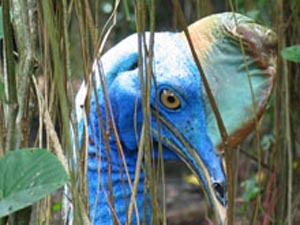
“Birds are the only wild animals most people see every day. No matter where we live, birds live with us. Too many of us take them for granted. We don’t appreciate how very strange they are, how different. We don’t realize what otherworldly creatures they are.”
The prolific Sy Montgomery has written about dolphins, tigers, snakes, bears and gorillas. She also has a best-seller to her credit, “The Good Good Pig.” It is about living 14 years with her ever-growing pet, Christopher Hogwood. In “Birdology,” she takes on the class Aves, covering seven species. She devotes a section to each, and describes everything from the common to the rare and deadly. She also tells readers about the “birdologists,” who are the people who attempt to understand and learn from birds. In her introductory primer, Montgomery lays out “essential truths” she learned while researching and writing “Birdology.” She reminds readers that birds have been around a lot longer than man. In his 1990 classic thriller “Jurassic Park,” author Michael Crichton has the main character inform us that birds evolved from dinosaurs. Montgomery does the same, even more emphatically. This book, which is organized like a collection of short stories, opens with the common chicken. Montgomery explores individuality, personality and intelligence in her brood of pet hens, which she calls the “Ladies.” Next, she heads to Australia to follow and observe one of the least-known and deadly creatures on our planet, the flightless cassowary. It is the third tallest and second heaviest bird, smaller only than the ostrich and emu. Then, going from one of the largest to the smallest birds, she devotes a chapter to people who rescue the “fairies” of “birddom,” hummingbirds. With humor, insight and reverence, Montgomery explores the worlds of three species that each, although as wild as all birds are, has a unique relationship with man: hawks, pigeons and parrots. She ends the book with a detailed description of her visit to a winter roost of crows in Auburn, N.Y., where the birds outnumber the humans 2 to 1. She explores this problematic situation with a team of experts attempting to understand these gatherings that plague many of our cities. Montgomery’s writing style is much like that of a good travel writer. She takes the reader along on her journey through an exotic world. She tends to be more than a bit pietistic, but beware. After reading her observations, you will never look at birds the same; you might even become a vegetarian. In a companion book , “Kakapo Rescue: Saving the World’s Strangest Parrot,” Montgomery gives us what could have been chapter eight of “Birdology.” “Kakapo” is intended for readers ages 7 to 10. Released at the same time, although by a different publisher, the book details the efforts to prevent the extinction of these giant New Zealand parrots. Heavy, friendly, sweet-smelling and unable to fly, these human-loving birds were once common. Now the fewer than 100 that remain are being re-introduced on the predator-free Codfish Island, off the southern coast of New Zealand. Montgomery and photographer Nic Bishop show readers the scientists and a group of dedicated volunteers who work diligently on a project that may, or may not, be successful. A fascinating report with stunning pictures, this book will appeal to adults as much as children. If you buy one of these books, look for the other. They really do go together.”
—C.F. Foster for the Florida Times-Union
“Growing up on a farm, I always thought chickens were bird brains in every sense of the word and that it was no great loss when a skunk or weasel breached the defenses of the henhouse. Turns out I was wrong. In BIRDOLOGY, Sy Montgomery not only describes in convincing detail how smart chickens really are, but the intelligence as well of hummingbirds, hawks, pigeons and cassowaries, aka dinosaur birds. A winner of multiple awards for her nature books for children, Montgomery brings an equally engaging style to this grown-up book about how crows are smart enough to put walnuts beneath the wheels of cars at stoplights, picking up the nutmeats after the cars have moved on, and how Alex the parrot (and others) learned to communicate with, and not just mimic, their caretakers. Fascinating facts abound: red flowers are particularly attractive to hummingbirds, which is good for pollination because bees don’t see the color red; pigeons have bits of magnetite in their upper beaks which allow them to sense the electromagnetic field of the Earth (a German study strongly suggests that birds’ peculiar eyesight may even allow them to see the electromagnetic field). ‘Birds are the only wild animals most people see every day’ and Montgomery’s stated goal to ‘restore both our awe and our connection to these winged aliens’ is admirably reached in this book.”
—Daily Herald (Utah)
“What makes a bird a bird? That’s what Sy Montgomery set out to discover in Birdology: Adventures with a Pack of Hens, a Peck of Pigeons, Cantankerous Crows, Fierce Falcons, Hip Hop Parrots, Baby Hummingbirds, and One Murderously Big Living Dinosaur. Sy is the author of the national bestseller The Good Good Pig: The Extraordinary Life of Christopher Hogwood, as well as 15 other nonfiction books. In Birdology, she uses compassion, humor and fascinating facts to explore and understand the lives of seven types of birds. The author studies bird communication, personality, homing and hunting abilities, as well as their relationship to dinosaurs. A must-read book, for birders, bird-lovers, and anyone with an interest in these beautiful creatures.”
—Supercoolpets.com
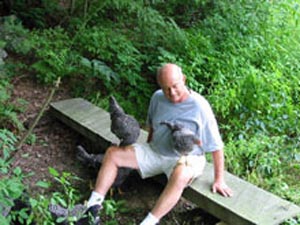
“When I read my first Sy Montgomery book last summer, I was so moved and delighted, I gobbled up her whole oeuvre as fast as I could. The punishment for my greed was having to wait until now for a new book, Birdology: Adventures with a Pack of Hens, a Peck of Pigeons, Cantankerous Crows, Fierce Falcons, Hip Hop Parrots, Baby Hummingbirds, and One Murderously Big Living Dinosaur. Close to the end of this Birdology, I read a dozen or so pages with such a degree of actual joy and burgeoning enthusiasm, I felt an impartial reader was required. The chosen subject – who also happens to be a Ph.D. archeologist – read the same pages. Although perhaps a bit less gaga, he was no less charmed than I by the extraordinary mixture of science and awe, nature and culture, riveting factoids and generous story that is Montgomery’s stock-in-trade. Whatever her ostensible subject, she writes about ‘The Place,’ the intersection where the human and nonhuman worlds, where past and present, meet and co-create in relation to one another and themselves.
A chapter for each is devoted to chickens, cassowarys, hummingbirds, hawks, pigeons, parrots and crows, the chapter subtitles suggesting an apparent design to report key aspects of bird physiology: “Birds Are Individuals,” “Birds Are Dinosaurs,” “Birds Are Made of Air,” “Birds Are Fierce,” “Birds Find Their Way Home,” “Birds Can Talk,” “Birds Are Everywhere,” an implicit promise that is kept, even as what is delivered is far more ample and ambitious: the restoration of “both our awe and our connection to these winged aliens who live among us.” “Birdology” is a term coined by Rev. Elaine Bomford, who claimed in a sermon Montgomery attended while she was writing the book that birdologists experience “the divinity of creation revealed in birds.” Yet, while the term “birdology” suggests it should be to birds what anthropology is to humans, Montgomery’s “Birdology” is a rich blend of the two: as she writes about species of birds and individual birds, she also writes about the relationships — general and specific — between the bird and human worlds. The chapter on chickens focuses on her own “Ladies”; in the chapter about Cassowarys, she introduces the people who live in close relation to them, including a couple whose garden is regularly visited by these giant “living dinosaurs.” One of the book’s most admirable human characters is hummingbird rehabilitator Brenda Sherburn, whose excruciating regimen and heroic efforts to save two baby hummingbirds Montgomery details. Montgomery learns the rudiments of falconry to investigate hawks and then wrestles with the life-changing decision whether to continue that austere discipline. She frequents pigeon racers and parrot owners, dances on her birthday with the particularly rhythmic parrot Snowball, visits cities where crow invasions have created material havoc and political turmoil: this is Gonzo Journalism at a whole other level. Montgomery’s intrepidity and openness to experience is fed by extensive scientific research and the collection of choice anecdote. Typical passages combine these disparate sources seamlessly: ‘… I tried to decipher the chickens’ language. At first my husband dismissed our efforts, insisting that most of what they were saying was, ‘I’m a chicken. You’re a chicken. I’m a chicken.'” He gave them more credit than many scientists did for many years” introduces a discussion into chicken communication that meanders through an encapsulated history of scientists’ dismissal of bird communication generally, ancient augury, personal observation, an anecdote from Farm Life Forum’s web page for poultry keepers, a summary of the findings of a recent study at Macquarie University in Australia of Sebright chicken vocalizations including quotations from the researchers, returning to her personal relationships with her “Ladies.” Montgomery returns to birdsong in her parrot chapter where she details the similarities in structure and syntax between human speech and bird song, discusses the shared genetic ground for both and the similarities in the language learning process for birds and humans. Then she describes how the speech acquisition of a specific parrot, Alex, at the Pepperberg lab, relates to the more abstract knowledge; Alex’s love of rhyme segueing into a discussion of the relationship between language and music: “The kinship between the two is obvious: Plato observed that uplifting music resembles noble speech. Centuries later, Darwin proposed the idea that music was the immediate predecessor of language, arguing that the human voice was first used to attract a mate. (That trick is still working: after all, by one calculation 40 percent of the lyrics of popular songs are still about sex and romance; and, indeed, the sexual success of pop singers — and jazz musicians, and even 19th century classical composers — seems to bear out the theory that a human’s ability to make music, like a bird’s ability to make songs, can be powerfully seductive.) And, although the issue is hotly debated, a sizable number of experts believe that our closest human relatives, the Neanderthals, lacked complex language — but sang instead.’ Montgomery then goes on to quote Steven Mithen, bringing rhythm into the theoretical discussion, before she returns to Snowball the parrot, caught dancing to polka music by himself … The otherness and the closeness of the bird and human worlds are a recurrent theme, along with their imbrication: ‘In the city, crows go even further: they manage to use human tools for their ends … Walnuts are a crop new to Japan, but lately groves seem to be spring up everywhere. Crows find walnuts tasty and nutritious, but the shells are too hard to open. The solution: crows pluck nuts from trees, then fly to perch on the traffic signal at the nearest intersection. When the light is red, they fly down and place the nuts in front of waiting cars. When the light turns green, the cars run them over, cracking the hard shells. When the light turns red again and the cars stop, the crows fly safely down to eat the nutmeats.’ The Montgomery genre creates an excitement of its own. In spite of the diminishment of the natural world she simultaneously chronicles, hope for all creatures is implicit in these encounters. One’s faculties for observation, awe and sympathy with the worlds hidden within ourselves and in plain sight all around us are developed and refined. While she eschews all preachiness, Montgomery’s impact is nonetheless that of an expert sermonizer: her reader cannot but emerge with a more capacious soul, a richer understanding and enhanced appreciation of ourselves and our world.”
—Leslie Thatcher in Truthout.org
“Sy Montgomery, who lives in Hancock with her husband, another fine New Hampshire writer, Howard Mansfield, recently hit the bestseller list with her charming memoir, THE GOOD GOOD PIG. But Montgomery has always deserved a wide readership. To gather material for her books she has been stalked by tigers in India, she has swum with the dolphins of the Amazon, and she has hiked in search of snow leopards and golden moon bears. She is adventurous as a naturalist and as a writer; and as a writer she is lyrical and precise. In her new book, Birdology, Montgomery catalogues her lifelong fascination with birds, those fascinating creatures all around us which we rarely truly see. Each of seven species teaches a lesson: chickens show how Birds are Individuals (smart and social); the cassowary reveals that Birds are Dinosaurs; pigeons, crows, hawks, hummingbirds and parrots impart lessons of their own. Throughout, Montgomery proves once again her preeminence in the flock of New Hampshire writers.”
—Michael Hermann of Gibson’s Bookstore for NEW HAMPSHIRE Magazine.
“Bird haters are in trouble with this one because Sy Montgomery’s “Birdology” is bound to fascinate, captivate and de-hate them. While bird lovers will have a field day, the rest of us who take birds of all feathers, colors and song too much for granted will turn wide-eyed for all the discoveries Montgomery’s pages offer. “Birds are as ordinary as they are mysterious,” Montgomery of Hancock writes, “as powerful as they are fragile, so like us and so beguilingly Other. These winged creatures, made of air, have outlived their kin, the dinosaurs. It is our duty and privilege to protect them.” In “Birdology,” she takes us on a frisky tour of habitats and experts. We go from the unheralded farmyard chicken to the real-life dinosaurianly dangerous Australian cassowary that weighs 150 pounds and stands six feet tall. This is the cut-throat flightless killer bird whose five-inch claws have slashed and stabbed its way into earning “the reputation as the world’s most dangerous bird.” Cassowary tracks, Montgomery writes, look exactly like the fossilized track ways of young Tyrannosaurus rex — so don’t tread on me, flat-footer. Does Sy Montgomery seek out an audience with a cassowary? Well, of course. On the way, we don’t learn merely about cassowaries. We learn that, contrary to what many of us have learned from school books that dinosaurs died out, dinosaurs live on; they evolved into the most diverse of the vertebrates-ten thousand species of birds. We also learn that Montgomery, on the search in the wilds, returns to the research station with blood-soaked clothes — leeches. “I look like I have been shot,” she reports, adding that leech bites bleed for hours. Leeches’ drool contains an anticoagulant to extend their feeding opportunity. Sy Montgomery is a naturalist-author of experiences with pigs, pink dolphins, scary woman-eating tigers and electric eels, pit snakes and piranhas. Although a cassowary is on this tour, Montgomery’s own fascination with the wild world seems this time the most irredeemably enjoyable. She seeks out an astonishing array of mysteries and spellbinding traits that birds give her and now us. From chickens to cassowaries and chickadees, she says, “we are communing across a gap of more than 300 million years.” She does finally meet a cassowary eye-to-eye, literally, and senses that “indeed I have traveled back in time: for neither I nor my species yet exists, and creatures like this one — intelligent, curious, serene — are, for now, the rightful rulers of the world.” The cassowary weighs too much to fly. On the other hand, a hummingbird is born an inch and a half long and a breath wide. They, and other flying birds, “are made of air.” Their bones are hollow, their bodies contain air sacks. Hummingbirds alone can truly hover, fly backward, fly upside down. Given its body weight, hummingbirds can do what no fighter jet pilot in a slow-poke F-16 on the wing can ever do. These truly awesome birds plunge earthward so fast that when pulling out of the dive a hummingbird exerts more than nine times the force of gravity on its body. Allen’s hummingbird, the fastest bird in the world, dives at 383 body lengths per second. Their wings beat more than sixty times per second. Their resting heart beats five hundred times a minute, in flight fifteen hundred times a minute. No wonder Montgomery wants to convince us of the marvels of birds-what we otherwise would miss knowing! These all are stupendous creatures. An eagle at one thousand feet altitude can spot prey within a three-square-mile plain. Our eyes comprise 2 percent of the human face; a European starling’s eyes account for 15 percent. Our eyes would be the size of oranges were we a great horned owl. In the human, the fovea (the center of the field of vision) detects detail with two hundred thousand cones to each square millimeter. Sparrows have twice that number. Raptors as Harris’s Hawk and the peregrine have more than a million. The wonders accrue. Cockatiels “talk.” (Aristotle named his pet parrot Psittace; neither one of them were dummies.) Pigeons navigate the electromagnetic field of the heavens to fly home. Brainy crows abide by family loyalties, beak-kiss one another on tree branches, roost by the thousands, ten thousands, hundreds of thousands (as in Auburn, N.Y.). Montgomery’s book is filled with fascinations. She adds just enough of herself to give us a smooth mix of you-are-there and listen-to-this as we follow her on another wildlife adventure of the amazing. We can be pleased that “Birdology” finally arrived because Sy Montgomery says: “I have waited a long time to write this book.”
—Steve Sherman in The Keene Sentinel
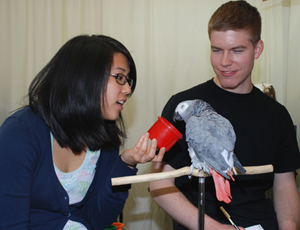
“Birdology by Sy Montgomery (Free Press, $25.00, 272 pages) is a humdinger of a book all about our feathered friends —birds like hens, pigeons, crows, falcons, hummingbirds, etc. Written with verve, with expertise aplenty, with heart and a poet’s sensibility, the writer who lives in New Hampshire like the reviewers, struts her stuff and we are all the better for it. Sy Montgomery writes with a sense of wonder and shows her true feelings and knowledge in page after page of this wonderful tome that is a consciousness raising behind the scenes look at some of our feathered friends. MUST READ.”
—Frommer Luxury Travel
“Sy Montgomery entertains with her fascinating stories and well-researched facts about a wide variety of birds. Her passion engages you; you are with her as she stares into the eyes of a hawk. This is the first non-fiction book that I carry around with me so that I can read it at every available moment.”
—Powell.com Daily Dose
“New Hampshire naturalist Sy Montgomery has written about snakes, tarantulas and other animals for children, as well as about great apes, tigers and other animals for adults. But she’s wanted to write a bird book since 1984, she notes in the introduction to “Birdology,” whose title concept she borrows from a word coined by a visiting pastor at a church where Montgomery and a friend were drawn one Sunday to hear this intriguing sermon topic.
A birdologist needn’t be an ornithologist with university degrees, but rather anyone who appreciates birds, anyone whose soul is strengthened by watching them and who ” ‘experiences the divinity of creation revealed in the birds.’ ” Their flight, song and beauty “teach us reverence,” Montgomery believes, and in these avian adventures, she shares knowledge and enthusiasm for seven species, some familiar, others exotic. Repeatedly, she reminds readers, birds are individuals. For example, among her flock of chickens, some of “the Ladies” are bold, noisy and reckless while others are shy, quiet and cautious. One is sweet but a tad slow mentally, even for a hen. The birds recognize each other by facial features; they remember and anticipate. They can acquire language understanding — a human’s call to eat, for instance — and share information by a wide variety of sounds. In her chapter on pigeons, Montgomery focuses on the miraculous ability of these birds to find home. How? We know that keener senses enable their magic act. They see ultraviolet light and hear sounds below the register detectable by the human ear; they sense the Earth’s magnetic fields and changes in barometric pressure. Among other skills, they recognize landmarks, use the sun as a sky compass or polarized light to fix directions, and familiarize themselves with particular areas’ aromas. One of the most engaging chapters focuses on Montgomery’s friend Brenda Sherburn, who raises orphaned hummingbird chicks. These tiny gems hatch without feathers from eggs the size of navy beans yet, if well fed, can fledge in as little as two weeks. Montgomery flies to the Bay Area when Sherburn takes on twin Allen’s hummingbirds, which are known for their curiosity. The chicks must be fed a “fruit-fly-nectar cocktail” every 20 minutes. Too little and they die; too much, they explode. At the other end of the spectrum are Australia’s 6-foot-tall, 150-pound, flightless cassowaries, the living dinosaurs of Montgomery’s title. They sport bald blue heads topped by a crest of bone and 5-inch, daggerlike spurs on each three-toed foot. They eat fruit and love meat — especially dead rats — but have become extremely secretive since humans hunt them for meat. Montgomery’s search to catch sight of one provides ample opportunity to discuss birds’ descent from dinosaurs. It’s easy to catch Montgomery’s interest in and affection for everything from crows to hawks to parrots. She’s an excellent birdologist, spinning a narrative that’s part science and part personal anecdote. Birds “bring us messages from the divine,” she states. “They bring us news about… a world that we, with our merely human senses, have barely begun to perceive.”
—Writer Irene Wanner, formerly of Seattle, now watches birds in New Mexico, Special to The Seattle Times.
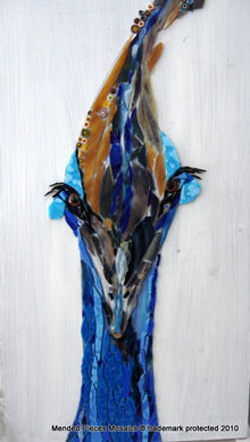
“If an Archaeopteryx of the Late Jurassic Period perched on our rooftops, we’d surely take notice. But rushing around, we often fail to see birds—the only wild animals that we encounter every day, and a link to our prehistoric past-eating berries from backyard bushes, drinking from puddles and raising young in delicate nests of stray hairs and blades of grass. It’s a subject ripe with possibility for noted naturalist and writer Sy Montgomery (The Good Good Pig). Her new book, Birdology, reconnects readers with the “winged aliens” that fill our lives with movement, song and mystery. Each chapter reveals a fundamental truth about birds, such as Birds are Individuals (Chickens), Birds are Dinosaurs (Cassowary), Birds are Made of Air (Hummingbirds) and Birds Can Talk (Parrots). Montgomery draws a line from her beloved childhood parakeet Jerry to her current barnyard full of gregarious chickens and beyond, focusing on one aspect of these common birds’ anatomy, physiology or behavior-the hawk’s incredible eyesight, the amazing architecture of hummingbird wings—to hint at the larger wonders and mysteries of the approximately 10,000 living bird species. Her reporting takes her to a wildlife rehabilitator in California who specializes in baby hummingbirds the size of a bumblebee; to Australia to track down the dinosaur-throwback cassowary; to New England to hunt with birds of prey. She gets a seat at the start line at a Boston-area pigeon race, allows a dangerous Harris hawk to perch on her leather-covered hand and dances with a cockatoo. “Although we are separated by 325 million years of evolution,” she writes, “Snowball and I move together, as if in a mirror.” The often poetic, relaxed elegance of her observations make this adventure into the science and natural history of birds deeply satisfying. Whether keeping watch over a newly relaunched hummingbird until he is “just a silhouette that dissolves into the soft, moonlit night” or putting a hood on a bird, “like extinguishing a candle,” Montgomery’s microscope reveals feathered creatures with intellectual and emotional abilities remarkably like ours, animals that “stir our souls in ways that change our lives.”
—Deanna Larson for BookPage
*Starred review! “Nature books can be downers, but this book is different. The people we meet—the researchers, rehabbers, enthusiasts, and fanciers with whom the author, in Plimptonesque fashion, immerses herself in order to get closer to her avian subjects—are all well-intentioned, compassionate folks. A “birdologist” seeks the divinity of creation revealed in birds, and it is this faith that drives Montgomery (The Good Good Pig) to restore her readers’ “awe and connection to these winged aliens…” She writes of just seven species (ranging from the exotic cassowary to the common crow), but her clever chapter arrangement gives a sense of their marvelous diversity. But Montgomery’s impressionistic account is as much about humans as it is birds, as much about the author’s own transformative experience as it is about the feathered vehicles of her change…VERDICT This volume will appeal to backyard birders and animal lovers as the author has a knack for making abstruse science palatable. Hers is a poetic sensibility expressed in prose; readers looking for bird poetry may want to consider Billy Collins and David Allen Sibley’s Bright Wings.”
—Robert Eagan, Windsor P.L., Ont. for LIBRARY JOURNAL
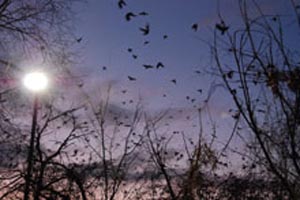
“Montgomery gives herself over so wholeheartedly to animals, and other humans who share her passion for creatures both rare and ubiquitous, that her nature chronicles are uniquely radiant. Mammals, from tigers to dolphins, bears, and one very special pig, have been her specialty, but birds have always fascinated her, hence this gathering of stirring avian encounters. Montgomery assists a hummingbird rehabilitator in the delicate raising of two tiny orphans, and meets the ‘most dangerous bird on earth,’ the enormous, razorclawed cassowary in Australia, one bird whose dinosaur ancestry is blazingly apparent. She also writes from unexpected perspectives about falcons, crows, pigeons, chickens, and parrots, each intriguing tale illustrating one of the ‘seven essential truths about birds,’ and all revealing fresh insights about birds, interspecies communications, and environmental concerns. Inspired equally by all that we share with birds—similarities in intelligence, emotion, language, and music—and all that is mysterious (birds ‘remain fundamentally wild’), Montgomery expresses profound appreciation for the living web of life in a book that both bird lovers and readers new to bird lore will find evocative, enlightening, and uplifting.”
—American Library Association’s BOOKLIST
“Sy Montgomery does for birds what Jane Goodall did for apes. With an infectious sense of adventure, and a sense of awe and mystery, Sy reveals the intelligence of tool-making crows and the intricate relationships between hummingbirds. Her stories change the way we look at even the most ‘common’ birds and instill in us a deep sense of gratitude that we are privileged to share this planet with such delightful creatures. Birdology is bound to become a classic.”
—Stacey O’Brien, author of Wesley the Owl
“Sy Montgomery may be the best interpreter of animals of all time. With impeccable science and profound respect, Birdology describes the miracle of these apparently familiar beings. We take them for granted and that is our mistake. In fact, they are dinosaurs, still living on earth after two hundred and thirty five million years, with minds and abilities that often far surpass our own. One seldom finds a real page-turner as a source of important information, yet Birdology is all of that and more.” —Elizabeth Marshall Thomas, author of The Hidden Life of Dogs and The Social Life of Dogs
“From the first greeting of her charming hens to her celebration of crows in all their smarts and wit, Sy Montgomery has me hooked. One cannot read this book without imagining birds as special people, with emotions and personalities and sometimes an intellect not all that different from our own.”
—Dr. Don Kroodsma, author of The Singing Life of Birds
“There could be no better guide to the wonder of birds than Sy Montgomery. Her vibrant prose, infused with pure curiosity and excitement, engages and leads the reader down new paths of discovery. Montgomery’s empathy with wild things is as real as it is rare; yet she seems to like the people who study, care for, and work with birds just as much. This is a book about intense connections between people and birds. And it is through the human conduit that Montgomery unlocks some of the secret of how and what birds may be thinking. Read it, and you will never look at a parrot, chicken, hawk or pigeon in quite the same way again.”
—Julie Zickefoose, NPR commentator; author of Letters from Eden
“Sy Montgomery has once again taken animal writing to another level of consciousness, compassion and understanding. Birdology is a brilliant, strikingly original, and beautifully written look into fragile, rich story of birds, whose lives are more varied, endangered, individualistic, and powerful than dogs and cats. I’ve never read anything like this about birds. These stories will haunt and enrich you, and they remind us how important birds are to our history and ecosystem. And how much they need our attention.”
—Jon Katz, author of A Dog Year and Katz on Dogs
“Sy Montgomery has the mind of a scientist and the fierceness of a raptor as she dives beneath the skin and deep into the bones of the avian world in Birdology. Brimming with insights about hidden bird abilities and the secrets of their behavior, the book is at its heart about the emotional bond between birds and people. Whether describing the gentle art of keeping hens or the bloodcurdling perils of falconry, Sy’s writing dazzles like hummingbird feathers drenched in blazing sunshine.”
—Bob Tarte, author of Enslaved by Ducks and Fowl Weather
“One of America’s pre-eminent writers on animals, the immensely talented Sy Montgomery leads us on a compelling journey of exploration into the very depths of what makes a bird a bird. With wit, compassion, and a cornucopia of fascinating facts, she delves into the lives and sensibilities of seven types of birds, tracing our relationship to them throughout evolution and human history. From hawks to hummingbirds and crows to cassowaries, Sy highlights bird language, individuality, homing and hunting abilities, and relationship to dinosaurs in a manner that not only reveals her deep love for birds, but also her inner quest to understand all living things. With this book, birders, animal-lovers, or anyone with a mild curiosity about birds, will gain a new-found respect and appreciation for the essence of these avian marvels.”
—Don and Lillian Stokes, authors of Stokes Field Guide to Birds
“Montgomery weaves a delightful, insightful story of the unusual lives of familiar birds to show us that they are personable, fun, annoying, lovable, and awesome and do indeed, strike into our very souls. Her tales are an astonishing, wide-ranging blend of science, art, humor, understanding, and love, and a must read for all animal lovers. Montgomery captures not only the incredible and astonishing variety of bird behavior and intelligence, but the essence of the very soul of birds.”
—Joanna Burger, Distinguished Professor of Biology, and author of The Parrot Who Owns Me
“This is my favorite kind of book: charming, witty, and wise, idiosyncratic and inspiring. And Birdology is Sy Montgomery at her very best. Not a catalog, list, or inventory, Birdology is more like a novel, a confession, or an engaging memoir of life lived with soul and wings. I love this book.”
—Dale Peterson, author of Jane Goodall: The Woman Who Redefined Man and Elephant Reflections
“Birdology allowed me to see even birds I know well with new eyes. Sy Montgomery writes about seven avian species and the people who love and protect them with such skill, knowledge and empathy that her book will surely delight any and all readers… her prose is filled with beauty, and I was enthralled by her story of tracking down a wild cassowary in Australia. A thoughtful, fascinating book for birdlovers and non-birdlovers alike.”
—Suzie Gilbert, wildlife rehabilitator and author of Flyaway and Hawk Hill
“We see birds every day, and often take them for granted. But in Birdology, Sy Montgomery explores the wonders and mysteries of the living dinosaurs among us, revealing not only their beauty but their strangeness and individuality. Her explorations among scientists, falconers and pigeon fanciers shows birds as they really are, both like us and “other”, with startling intelligence and almost magical abilities.”
—Steve Bodio, author of Eagle Dreams, Aloft, and A Rage for Falcons
“Spell-binding, absolutely compelling, and so beautifully expressed, Birdology tells stories that everyone should know. Nobody has ever gone so far into the minds of birds as Montgomery has. She completely conveys the life, the obsession, the fascination with birds in an intimate, personal and engaging style. A magnificent achievement.”
—Jeffrey Moussaieff Masson, author of When Elephants Weep and Dogs Never Lie about Love
